Day 5 of a five day Spring Migration tour today, the final day. It was another gloriously bright and sunny spring day, and much warmer than of late too. Once again, a great day to be out birding in Norfolk.
Our first stop was at Holkham. There was lots of activity around the trees and grazing marshes – lots of Cormorants on their nests and Egrets coming and going. We could see several Spoonbills perched up in the bushes and, through the scope, could see their shaggy crests and yellow-tipped spoon-shaped bills. Several flew out and circled round and two dropped down into the wet rushy pools out on the grazing marshes where they started feeding, heads down and consequently quickly disappeared from view in the vegetation.
As usual, there were lots of geese out on the grass, mostly Greylags, but with a good scattering of Canada Geese and Egyptian Geese too. A careful scan of some more distant geese on the old fort revealed three Pink-footed Geese just in view behind the bank. We could see their dark heads and smaller, darker bills that the nearby Greylags.
There were lots of Marsh Harriers circling round. We watched a male collecting nest material, carrying it back into the reeds. When a Common Buzzard flew towards the trees, he dive bombed it, the Buzzard turning upside down and raising its talons in response. displaying. As we were getting ready to leave, he started displaying, swooping down in a series of switchbacks.
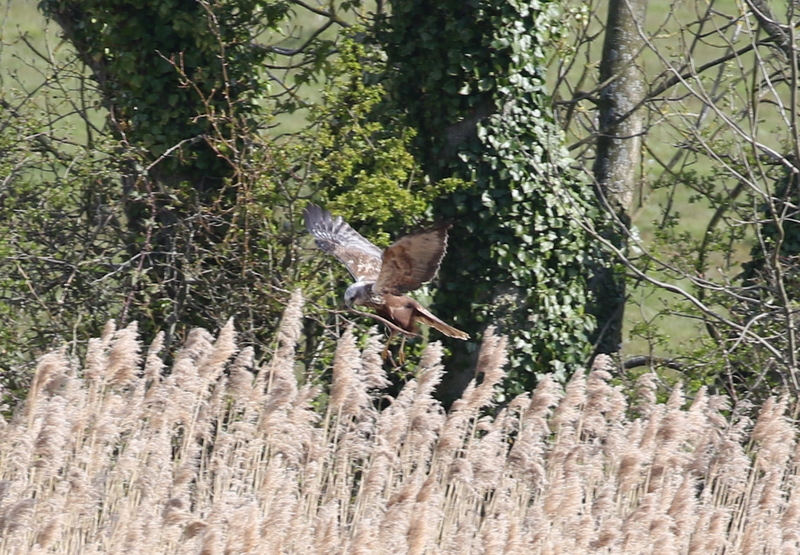 Marsh Harrier – collecting nest material
Marsh Harrier – collecting nest material
There were lots of warblers singing from the hedges, as we walked out across the fields towards Burnham Overy Dunes – Whitethroats, Lesser Whitethroats, Chiffchaffs and a smart male Blackcap.
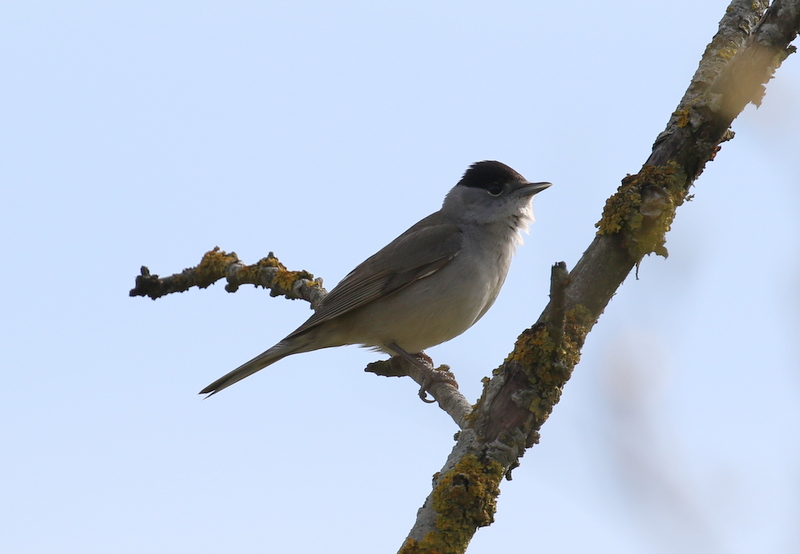 Blackcap – singing from the hedge along the track
Blackcap – singing from the hedge along the track
There was a bit of a breeze, which meant that the Sedge Warblers along the ditches either side of the track were mostly keeping down in the brambles, but we eventually found one which perched up in view.
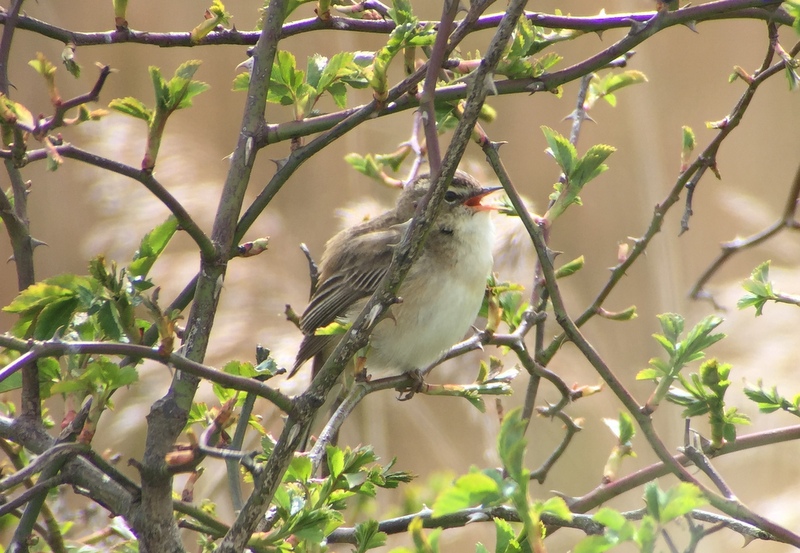 Sedge Warbler – one eventually perched up singing for us
Sedge Warbler – one eventually perched up singing for us
The stockman came down the lane in his Land Rover and went out into the fields to check on his cattle. As he did so we heard a Whimbrel calling as it flew off. Thankfully it circled round and landed in the field on the other side, where we could have a good look at it through the scope, admiring its humbug-striped crown.
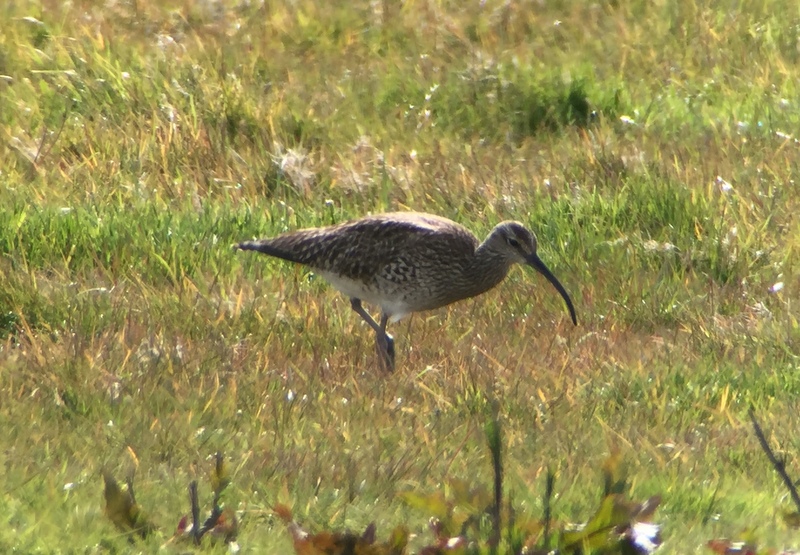 Whimbrel – feeding on the grazing marshes
Whimbrel – feeding on the grazing marshes
From up on the seawall, we could see more waders out in the harbour. A little group of godwits down in one of the channels including three Bar-tailed Godwits in with the more numerous Black-tailed Godwits. There were several Grey Plover including one coming into summer plumage, starting to sport a smart black face and belly and a brighter white forehead and upperparts. Two more Whimbrel were feeding in and out of the vegetation along the drier edge of the mud.
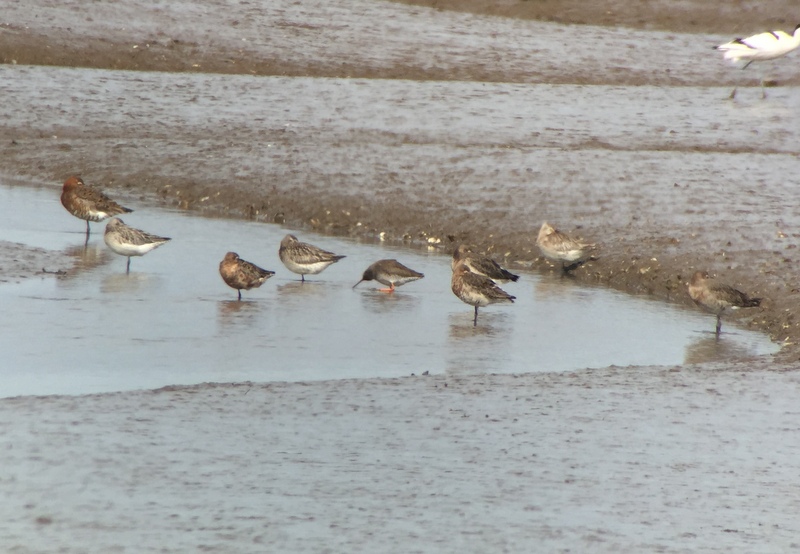 Godwits – three Bar-taileds were in with the Black-taileds
Godwits – three Bar-taileds were in with the Black-taileds
We could hear Mediterranean Gulls calling and looked up to see a pair circling high overhead, together with two Black-headed Gulls and a 1st summer Common Gull. Smart adults, we could see through their translucent pure white wing tips from below, unlike the other gulls.
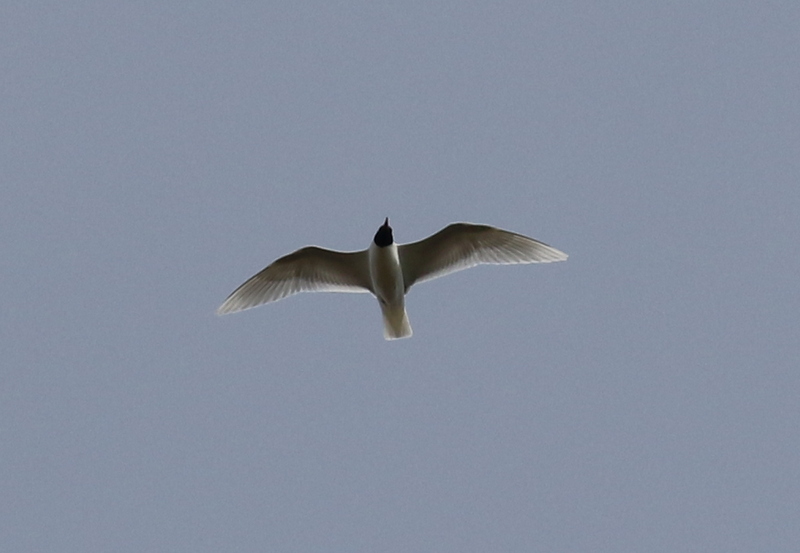 Mediterranean Gull – with translucent white wing tips from below
Mediterranean Gull – with translucent white wing tips from below
Out on the saltmarsh, there were still lots of Brent Geese. They should soon be departing on their way to Russia for the breeding season. A small party was feeding closer by and one of them was sporting colour rings. This bird (called BYB=) has been here for a few weeks now. It was ringed on the Taymyr Peninsula in Russia in July 2008, and has been seen here early in 2011 and 2013 too, but has also been seen in previous winters in the Netherlands and France, and in the spring in Germany.
Interestingly, BYB=, the colour-ringed Brent Goose appears to be paired with another interesting bird, which seems to have much paler flanks than the other, regular Dark-bellied Brent Geese. It is possible that this is an intergrade or hybrid between two subspecies, a cross between a Dark-bellied Brent and a Pale-bellied Brent.
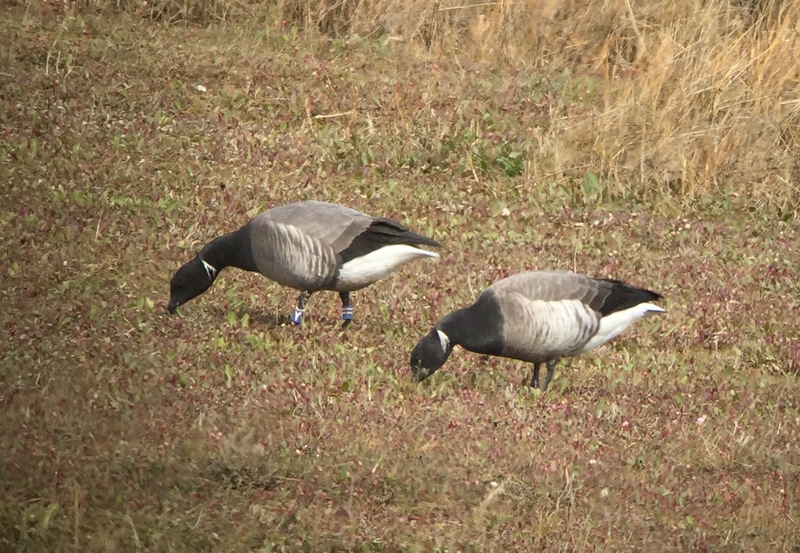 Brent Geese – a colour-ringed bird with a paler flanked than normal individual.
Brent Geese – a colour-ringed bird with a paler flanked than normal individual.
It was very busy out here today, perhaps not surprisingly given the fact that it was a sunny Sunday on a Bank Holiday weekend. Out at the boardwalk, we turned right into dunes. There were rather fewer than normal birds here, perhaps due to all the disturbance. A sizeable flock of Linnets flushed from the edge of the dunes as we passed, but settled back down again behind us.
We did find a nice group of Wheatears in a dune slack. They clearly wanted to be out in the middle, but had found somewhere quiet behind the fence where they were not so disturbed. There were several females and a could of smart males too, sporting their black bandit masks. A male Stonechat perched in the top of a bush, but we could find no trace of the Whinchats which were reported here yesterday.
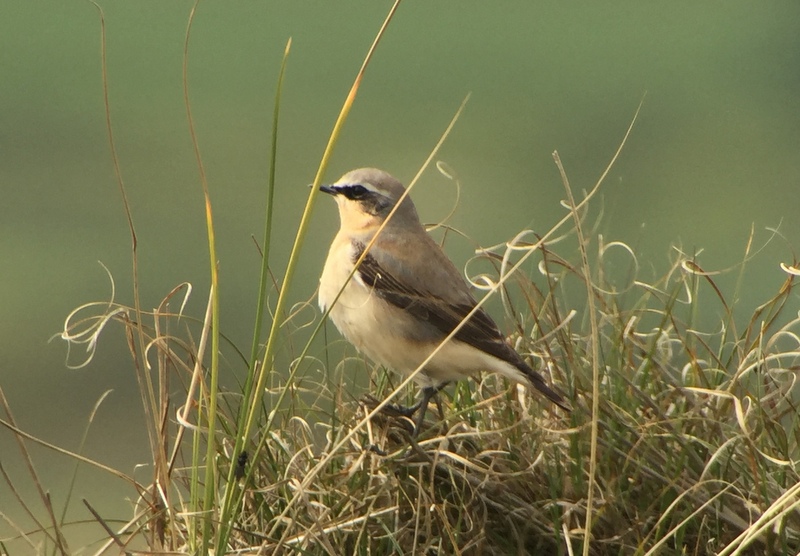 Wheatear – a small group had found a quieter spot beyond the fence
Wheatear – a small group had found a quieter spot beyond the fence
A Cuckoo shot past, looking rather like a cross between a falcon and a hawk, with pointed wings, grey back and long tail. It had a Meadow Pipit in close pursuit. It landed briefly, but the Meadow Pipit proceeded to mob it remorselessly until it flew again.
Over the grazing marshes, we could see two Spoonbills approaching and we had a nice view of them as they flew past us, just to the south of the dunes, and continued on over the seawall towards the harbour.
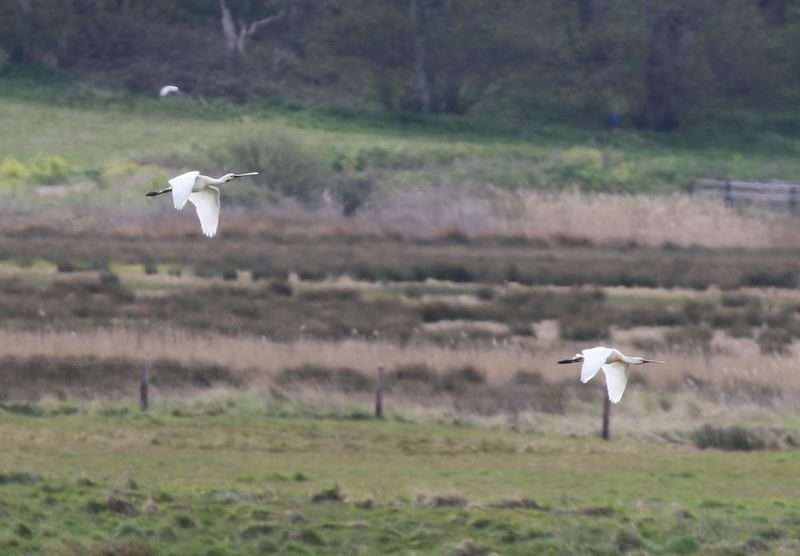 Spoonbills – these two flew past over the grazing marshes
Spoonbills – these two flew past over the grazing marshes
After the recent cold weather, many birds had obviously responded to the rising temperature to continue on their migration. There was a steady stream of birds overhead all morning. Several parties of Swifts and Sand Martins, a trickle of House Martins and Swallows. We heard a lot more Yellow Wagtails than we saw – their sharp flight call gives them away, even when they are too distant to be seen easily – but eventually we had a good view of one flying low past us.
There were also good numbers of Siskins passing overhead today. Again, their distinctive flight calls gave them away. In amongst some of the small flocks were Goldfinches on the move too. With all the Linnets in the dunes, it is always hard to tell here whether birds flying over are migrants or just local birds.
At the West End of the pines we could hear Mistle Thrushes calling. When one flew up into the trees, it was followed by a Ring Ouzel. It landed in the middle of a pine, on a branch close to the trunk, but we could just get it in the scope where it was. It was a smart male, black with a very prominent white gorget. When it flew out again, a browner female flew off behind it.
There are lots of Rabbit burrows in the dunes, providing a great food source for the local Stoats. While we were making our way round through the dunes, a Stoat ran across in front of us, followed shortly after by a second. They made a circuit round the bushes, then both ran off. When one Stoat came back, it made its way straight to a rabbit burrow. After looking at us nervously for a few seconds, it disappeared inside. We were hoping to see it come out with a Rabbit, but a few seconds later, just a head came out and looked around, before disappearing back inside.
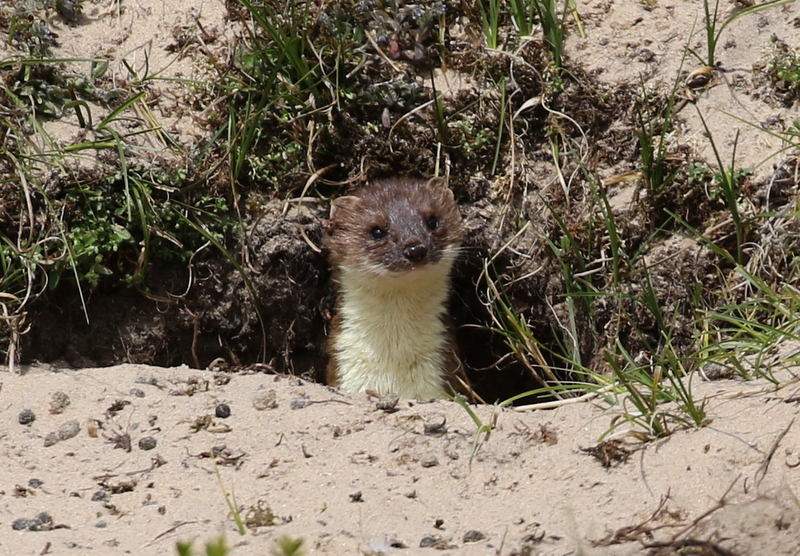 Stoat – two were chasing Rabbits in the dunes
Stoat – two were chasing Rabbits in the dunes
We made our way back through the dunes, and continued on for a quick look out to Gun Hill. There were plenty of people and fewer birds here too. A single Wheatear was out on the short grass. Three Little Terns fishing in the harbour were nice to see. And we flushed five Whimbrel up from one of the saltmarsh creeks as we passed by on our way. Back across the fields, a Lesser Whitethroat was singing from the blackthorn and showed briefly as it clambered about.
 Lesser Whitethroat – singing from the bushes by the path
Lesser Whitethroat – singing from the bushes by the path
While we had been out in the dunes, news had come through of a ‘trip’ of Dotterel along the coast at Choseley. We stopped for lunch at Burnham Norton on the way there – a lovely spot with beautiful views across the marshes. A Weasel ran across the path in front of us while we ate – much smaller and shorter-tailed than the Stoats we had seen earlier.
Up at Choseley, we found where the Dotterel were straight away. They were out in the middle of a large stony field. Some were running around, others were crouched in the furrows or preening. When they stopped still they were very hard to count. There were at least seven which we could see – though as may as nine had been reported earlier. Unusually, the female Dotterel is brighter than the male and we could see several smart females through the scope, with darker rusty bellies, a better-marked white line across the breast, and bolder white supercilia meeting at the back in a shallow ‘v’.
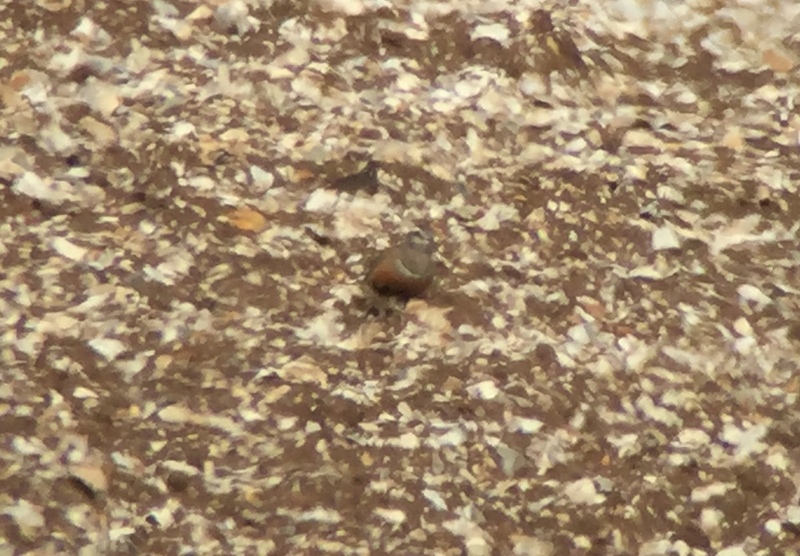 Dotterel – difficult to photograph with the heat haze!
Dotterel – difficult to photograph with the heat haze!
There was a surprising number of other birds in what appeared at first glance to be a barren field. There were several Wheatear hopping around, a few Skylark, a couple of Pied Wagtails and two Red-legged Partridge. Several Brown Hares included a pair which indulged in a brief bout of boxing. A drive round via Choseley produced fewer than hoepd for small birds in the hedges, but its was increasingly windy this afternoon. However, we did come across several more Brown Hares in the fields.
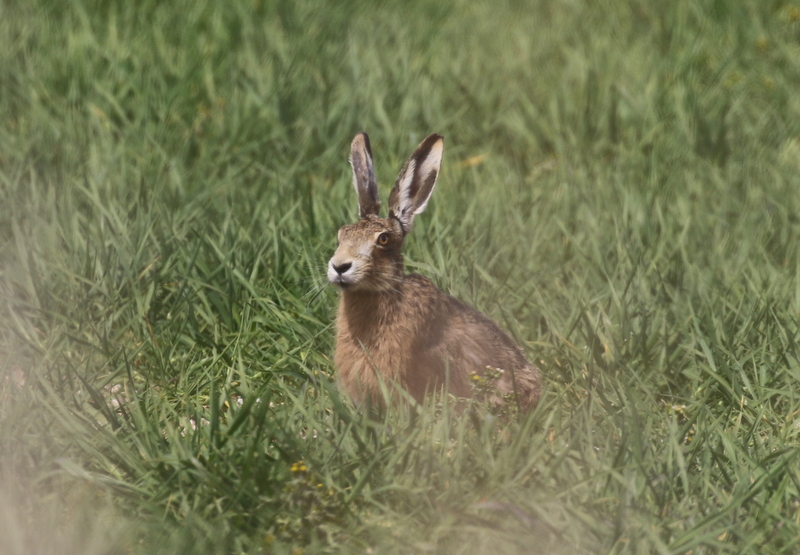 Brown Hare – there were plenty in the fields this afternoon
Brown Hare – there were plenty in the fields this afternoon
Back at Holkham, we had enough time for a quick walk out along the edge of the pines. Blackcap and Chiffchaff were singing from the poplars. A pair of Treecreepers flew past calling, and one landed on a tree nearby in full view. We could hear various tits and a Goldcrest singing.
We stopped to scan the grazing marshes. There was no shortage of Greylag Geese and Egyptian Geese as usual, but out on the grass we found a few Barnacle Geese too. Unfortunately, these are not true wild birds, but part of a local feral flock. In with them was rather odd-looking Ross’s Goose x Barnacle Goose hybrid, which is regularly around here and often mistaken for something rarer by the unaware.
A Spoonbill flew across in front of us and dropped down onto one of pools. It was hidden in the grass from where we were standing, so we walked along to Washington Hide for a better look. From the hide, we could see it bathing in the water, its nuchal crest blowing in the breeze. After a few minutes smartening itself up, it flew off back towards the colony.
 Spoonbill – dropped in to bathe on its way back this afternoon
Spoonbill – dropped in to bathe on its way back this afternoon
A Common Buzzard was perched in the top of a hawthorn bush out in the reeds. This was a rather regular looking brownish bird. But over in the distance we spotted a much paler one, with almost pure white underparts. Very pale Common Buzzards seem to be on the increase and provide another pitfall for the unwary, this one often being misidentified as a much rarer Rough-legged Buzzard.
Unfortunately, by this stage we were out of time and had to head for home so everyone could get away in good time, wrapping up a very successful bumper 5 day Spring Migration Tour. We had certainly seen some great birds!
















